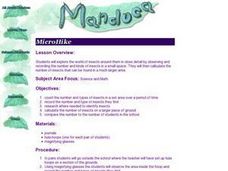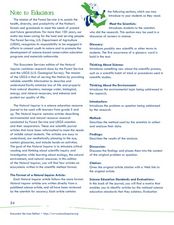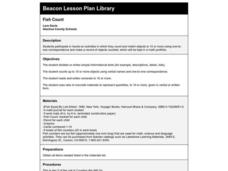Curated OER
Curious About Creepy Crawlies?
Students create oral presentations and visual aids to assist their inquiry about various insects. They reflect on the importance of learning about insects while working in small groups.
Curated OER
Water Quality
Learners examine the YSI and the water properties that it measures. They identify the different properties of water pH, DO, temperature, turbidity, and salinity and determine why it is important for them to test these parameters.
Curated OER
Investigating Erosion in an Outdoor Classroom
First graders observe the effects of erosion. They work in groups to simulate erosion in a streambed, participate in class discussion, read books about fossils and rocks and then go on a fossil hunt.
Curated OER
Problem-Based Research Lesson: Wilderness Issues
Students read and discuss articles relating to the theme "How should we deal with the growth of towns and human populations into wilderness areas?" Based on the class brainstorm, each student generates a research topic. They are grouped...
Curated OER
Love Them or Leave Them?
Students describe their pet and their feelings towards it and record their descriptive phrases on the board. They arrange comments on a spectrum from negative to positive. They read the article The Ambivalent Bond With a Ball of Fur and...
Curated OER
Evolution
Students illustrate the results of natural selection by identifying the specific adaptation of an organism that allows the species to survive in that environment. They illustrate the results of natural selection by recognizing examples...
Curated OER
Transformations And Animations in Polar Graphing
In this math worksheet, they investigate the polar graph of: r = a + b sin (t), for various values of a and b. This is called a limacon and is applied to the definition of a transformation.
Curated OER
MicroHike
Students observe insects in a small area. They calculate the number of insects in a large area as well. They share their calculations and observations with the class.
Curated OER
Triangular Numbers Are Everywhere !
In this math worksheet, learners observe that the triangular numbers are associated with the sums of consecutive natural numbers beginning with 1.
Curated OER
Masks: History and Artistry
Students research masks and their purposes,. They listen to the teacher read books about masks. Students study techniques for working with clay, they create masks from clay. Students take pictures of the process and the finished project,...
Curated OER
Birds, Bees and STDs
Students develop knowledge on STD's, their causes, treatment and prevention. In this investigative lesson students mingle with each-other to find the STD, then get into groups and research STD's on the CDC site.
Curated OER
Involving Community Members, Parents, and Community Agencies in Student Learning
Students predict and estimate the number of moose shot by people between the years of 1986-1990. They analyze data and statistics, construct bar graphs, and conduct research on the Alaskan moose.
National Security Agency
Expanding Place Value
Learners explore place value. This incredibly thorough and valuable mathematics lesson, has students make a number wheel to assist in the completion of a Place Value worksheet. Students use manipulatives and a place value mat to further...
Curated OER
What's the Frequency, Roy G. Biv?
Introduce starting space scientists to the electromagnetic spectrum, expecially the portion of visible light. Teach them about wavelength and frequesncy. Then give them a roll of adding machine tape and a manila folder to make a...
Curated OER
The Great Race
Students identify the mean, median and mode of collected data. For this statistics lesson, students collect, graph and analyze data using central tendencies. They work in groups to collect data on a robot through an obstacle course.
Curated OER
The Many Phases of the Moon
Fifth graders explore the phases of the moon as it relates to the calendar.
Curated OER
Using Primary Sources: Letters from the Presidents
Students find out about the minds and thoughts of presidents through reading their actual letters. They explore the personal lives of presidents. They answer questions about a primary source. They write essays.
Curated OER
Natural Inquirer Ecosystem Article Lesson
Young scholars discover new ways to preserve the ecosystem by completing graphic organizers. In this environmental lesson, students read an article from the Natural Inquirer in small groups and fill out a graphic organizer based on...
Curated OER
Surrounded by Radiation
Students explore ways in which people are constantly exposed to naturally occurring and man-made sources of radiation. They create and play a board game featuring different hypothetical scenarios of radiation exposure.
Curated OER
Our Robots, Ourselves
Students imagine how they might use a robot in their daily lives, explore advancements in artificial intelligence, investigate robotic technology under development, and prepare posters that show how robotic technology might be...
Curated OER
Acting Like a Hog
Young scholars explore game theory. In this secondary mathematics lesson, students plat the game of HOG using dice and explore the optimal strategies. Young scholars play the game three ways: any number of dice, a fixed...
Curated OER
A Distant View
Students investigate the essential concepts of how lenses work to magnify vision, and then build simple telescopes to demonstrate their understanding. They write a description of how their telescope could be improved and how it works.
Curated OER
Don't Burn, Baby, Burn!
Students consider products that provide protection from sunburn and other negative effects of the sun's ultraviolet rays. They develop or improve upon sun-screening products that are meant to provide protection for populations at risk...
Curated OER
Fish Count
Students participate in hands-on activities in which they count and match objects to 10 or more using one-to-one correspondence and make a record of objects counted, which be kept in a math portfolio.























